Family : Ophichthidae

Text © Giuseppe Mazza

English translation by Mario Beltramini
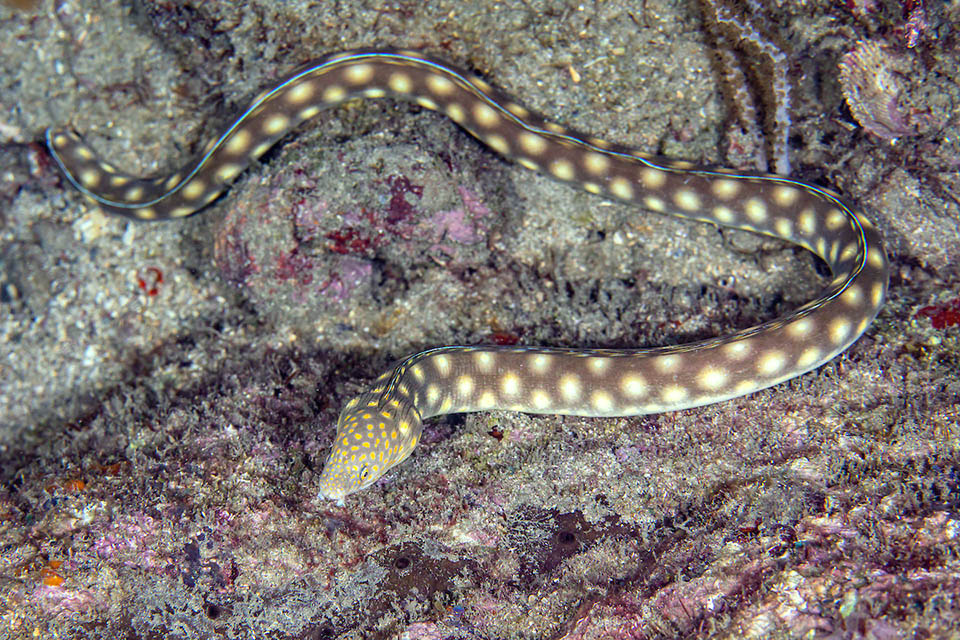
Myrichthys breviceps is a Caribbean snake eel that may be one metre long but usually only 30-75 cm © Allison & Carlos Estape
At first sight Myrichthys breviceps (Richardson, 1848) might be mistaken for a sea snake like Hydrophis elegans or a small moray like Echidna nebulosa or Gymnomuraena zebra and instead, even if like the morays is part of the Anguilliformes, is closer to the eels because like these ones has conserved in the course of evolution the pectoral fins.
Therefore, the taxonomists, considering all these aspects, have placed it in the family of the Ophichthidae, the so-called snake eels, an old group, born in the Lower Eocene, that nowadays counts 62 genera and 335 species. mostly tropical and subtropical marine fishes, but present also in freshwater, that may reach the 1300 m of depth feeding on fishes and crustaceans they find even in the darkness thanks to their exceptional sense of smell.
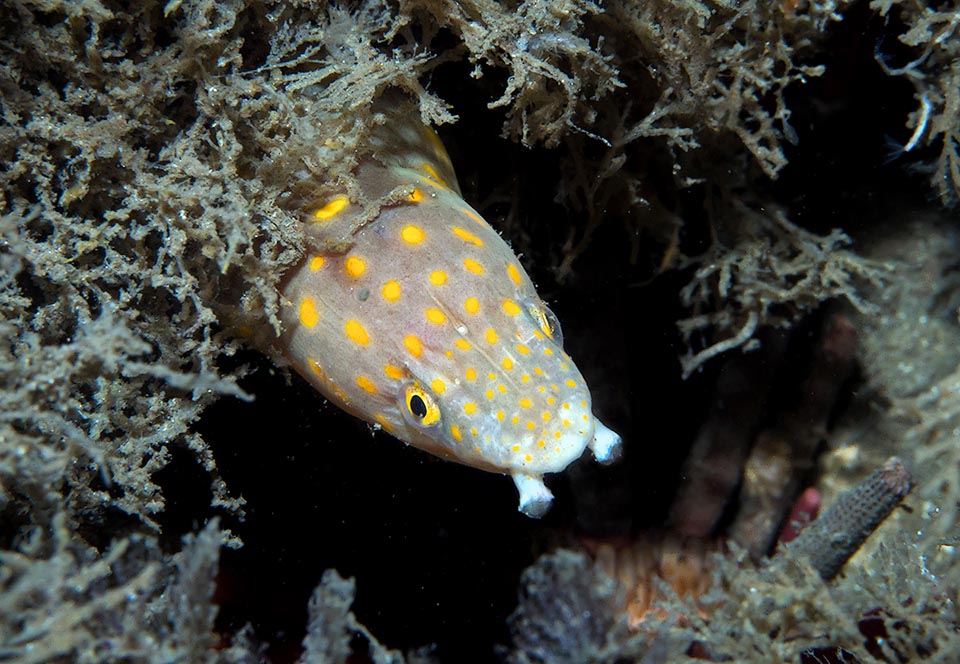
The head with characteristic orange spots has two showy tubular nostrils facing down plus two other olfactory holes on head that communicate with the mouth © Brian Cole
The name of the genus Myrichthys originates formed by “myrus”, name of an analogous species, Echelus myrus classified by Linnaeus as Muraena myrus, and by the Greek “ichthus”, fish, to highlight the similarity of this fish with the moray eels. The species breviceps, with short head, of Latin derivation, specifying that this the case of a fish similar to a moray having a small head.
Zoogeography
Considered common all over its range, but not locally abundant, Myrichthys breviceps is present in tropical and subtropical waters along the American Atlantic coasts from southern Florida, Bahamas and Bermudas up to the Yucatán Peninsula, and then Panama, Antilles, and Venezuela up to Brazil.

In fact it’s a fish locating the preys thanks to its very good sense of smell. On the body and the long dorsal fin reaching the anus, the pots of the head widen, clearing and getting blurry. Here we note, close to gill opening one of the two tiny pectoral fins that unlike the eels the morays have lost during the evolution © Allison & Carlos Estape
Carried by the currents the larvae have then reached the archipelago of Trindade and Martin Vaz, 1200 km far away from the continent.
Ecology-Habitat
Myrichthys breviceps is a benthic species living in shallow waters on sandy bottoms among coral debris and in the submerged prairies of phanerogams. Usually it rarely exceeds the 9-10 m of depth, but a sighting has been reported at 103 m.
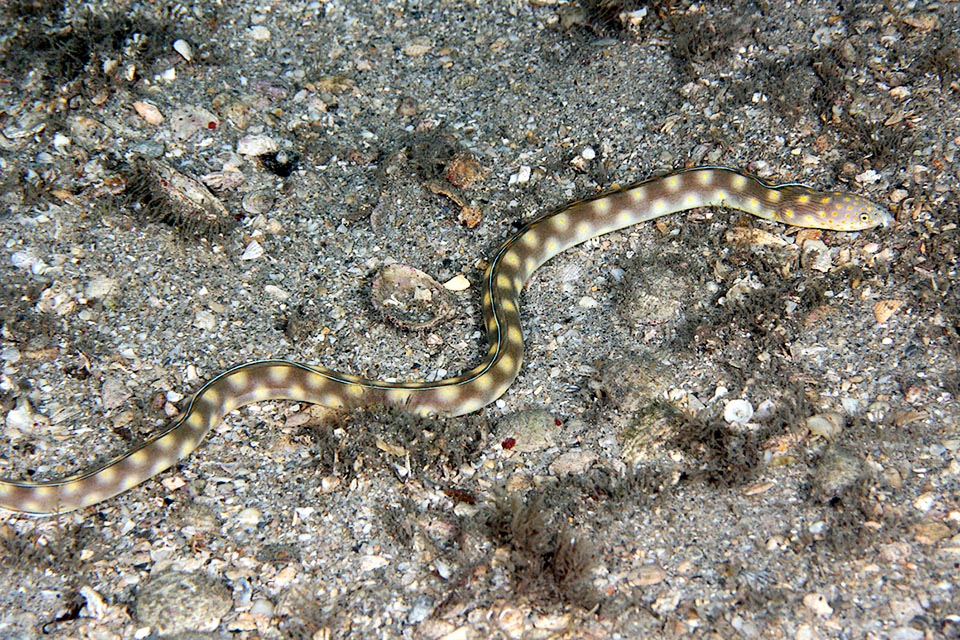
Myrichthys breviceps is a benthic species living in shallow waters, often on sandy seabeds wit coral debris rarely exceeding the depth of 10 m © Kevin Bryant
Morphophysiology
Initially the body is cylindrical and then progressively compresses more and more laterally towards the tail hence the vulgar English name of “Sharptail eel”, that is, Eel with the sharp tail. Exceptionally, it can reach the length of 102 cm, but the normal size stands between 30 and 75 cm. Like all Anguilliformes it has lost the pelvic fins, whilst the dorsal, the caudal and the anal have merged in a unique fin starting just behind the head.
Like morays, the skin is scaleless. On the snout, short and conical with the upper jaw longer, stand two showy tubular nostrils directed downwards and a little above are two olfactory holes connected with the mouth.
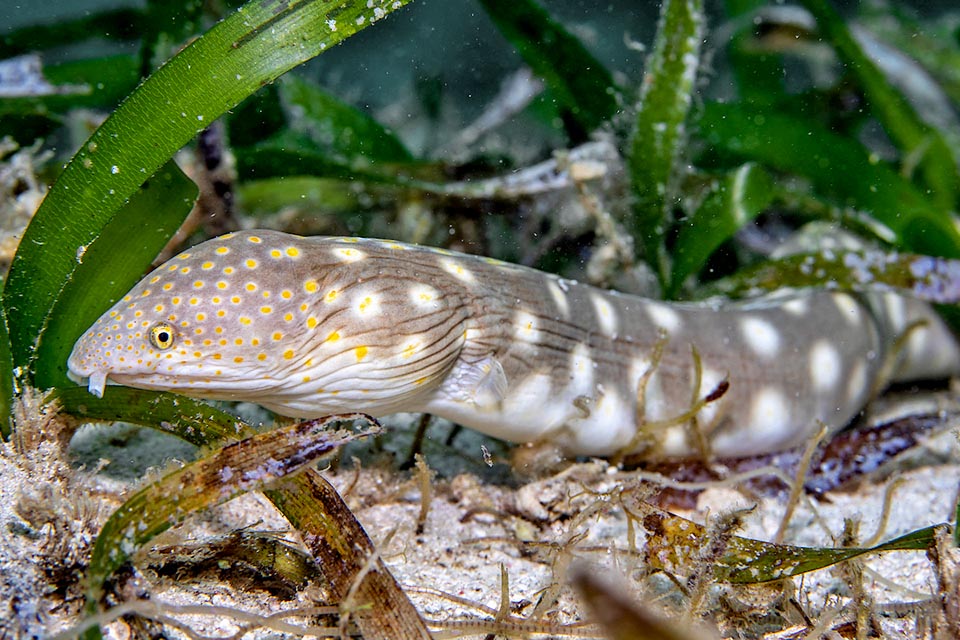
It also frequents the phanerogams prairies sticking its nose everywhere looking for small fishes, worms, shrimps and crabs it grinds with several rows of teeth © Allison & Carlos Estape
Inside, on the jaws and the palate, stand numerous rows of blunt teeth, molar or granular for shredding the preys.
The pectoral fins, located just after the gill half-moon openings, are very small and short with a wide base.
On the background colour, often brown but also grey, olive green or bluish, we note several yellow orange circular spots hence the French name of “Serpentine dorée”, that is Golden snake-eel. They are small, well marked but saturated with one colour only on the head because they widen progressively blurring at the edges with a very clear centre.
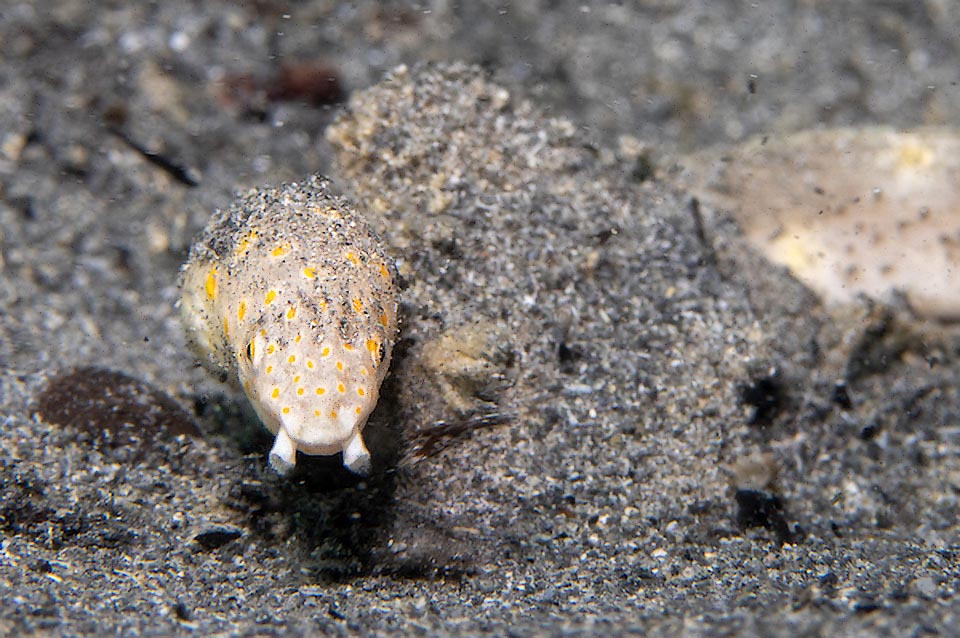
Fish allowing divers to approach it, however ready to hide darting under the sand as soon as it feels threatened © Allison & Carlos Estape
These distinguish them at first sight from quite similar species such as the Goldspotted snake-eel (Myrichthys ocellatus) with yellow spots circled in black and the Blackspotted snake eel (Quassiremus ascensionis), who, conversely, has them dark.
Ethology-Reproductive Biology
Myrichthys breviceps feeds on small fishes, crabs, shrimps, mantis shrimps and worms it often eats hidden with the head stuck into their holes. It hunts at night, but can be met also during the day exploring the seabeds. It allows the divers to approach it, but quickly takes refuge under the sand as soon as it feels threatened.
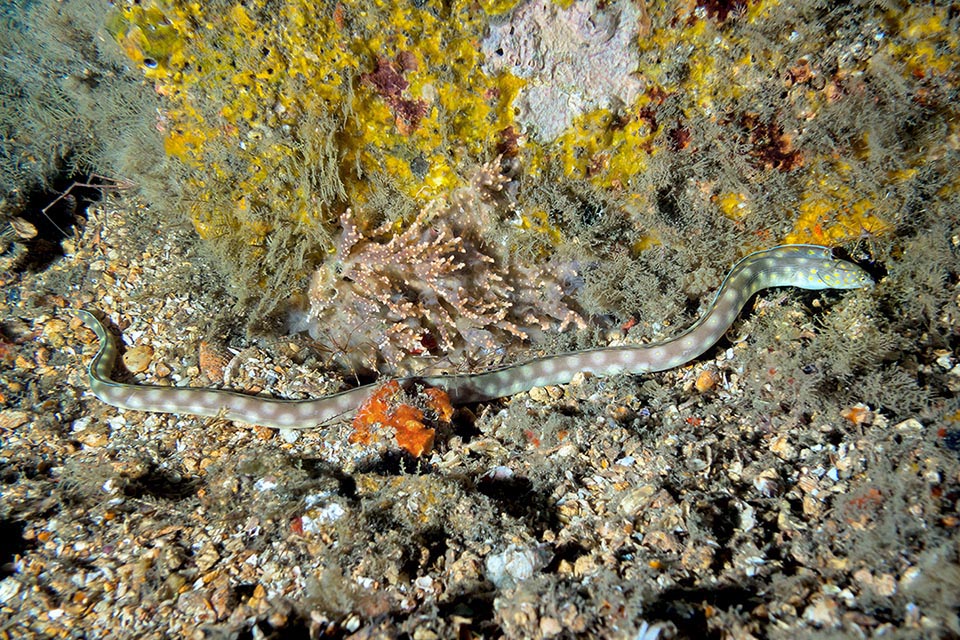
It hunts mainly by night but can be met also during the day while it’s exploring the bottoms, here attracted by the smell of a den © Brian Cole
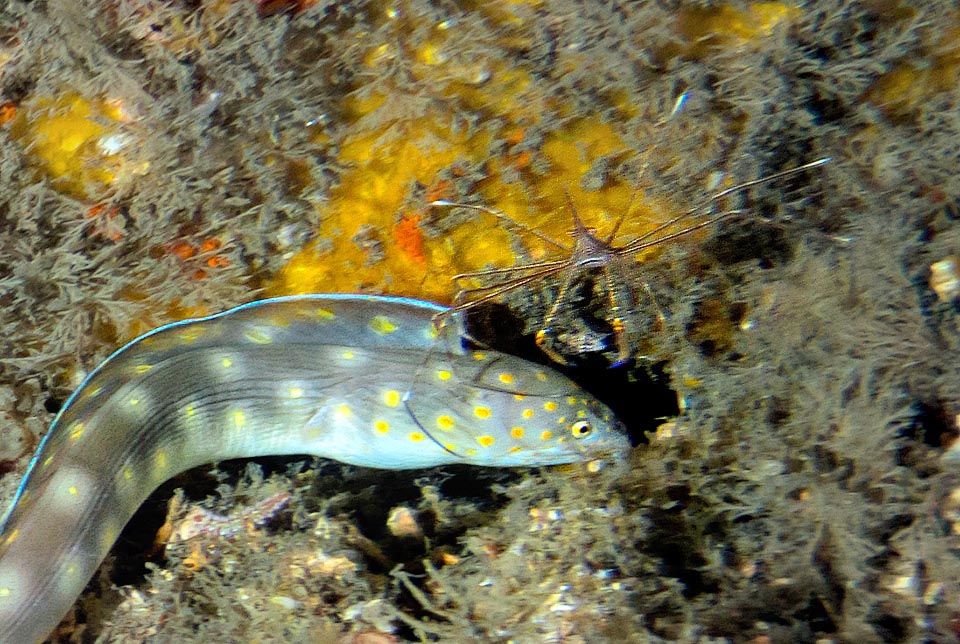
Enlarging the image we note close to the hole an arrow crab (Senorhynchus sericornis) who apparently is ignored. It could eat it but respects it, maybe because in the den has smelled more pulpy preys or because it’s a friend species who frees many reef fish like squirrelfish and the moray eels, from the annoying skin parasites © Brian Cole
The reproductive modalities are still to be partially discovered. We know that it is an oviparous species that reproduces in pairs and that the fecundated eggs are pelagic. Also the larvae wander for a long time in the open seas carried by the currents while growing, they assume the typical shape of the Anguilliformes, called leptocephalus, similar to a transparent willow leaf, with very small head and protruding needle-like teeth.
The leptocephali do not catch zooplankton, like the normal larvae of the fishes, but they grasp tiny food particles carried by the currents. They can swim backwards with rapid undulatory movements or curl assuming the appearance of a small wandering cylindre that renders them similar to a not very palatable gelatinous mass like the jellyfishes.
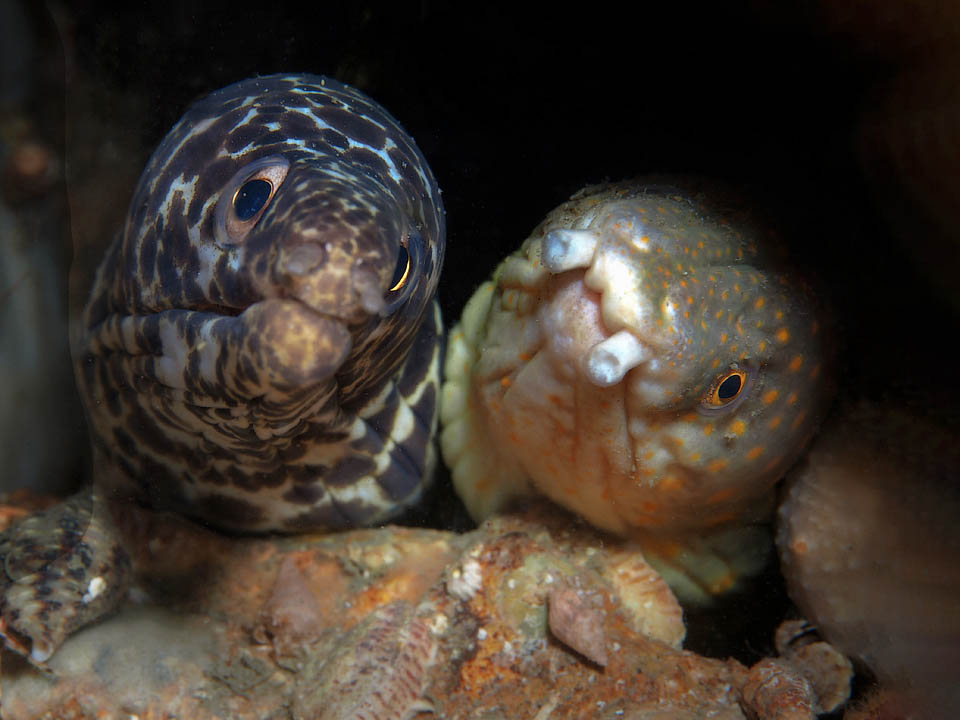
Here with a Spotted moray (Gymnothorax moringa) with terrifying teeth. Perhaps friendship exists also under the sea and they wait for the night to hunt together © Pauline Walsh Jacobson
The resilience of Myrichthys breviceps is average with a minimum time for doubling the populations of 1,4-4,4 years and the fishing vulnerability, high, marks 61 on a scale of 100. However, it appears as “LC, Least Concern”, that is not at risk, in the 2012 evaluation of the IUCN Red List concerning the endangered species, considering the ample distribution and the fact that there are not known serious threats.
Synonyms
Ophisurus breviceps Richardson, 1848; Muraena acuminata Gronow, 1854; Myrichthys acuminatus (Gronow, 1854); Pisodonophis guttulatus Kaup, 1856; Ophisurus longus Poey, 1867; Ophichthys pisavarius Poey, 1876; Leptocephalus undulatus Strömman, 1896.
→ For general information about FISH please click here.
→ For general information about BONY FISH please click here
→ For general information about CARTILAGINOUS FISH please click here.
→ To appreciate the BIODIVERSITY of BONY FISH please click here.
→ To appreciate the BIODIVERSITY of CARTILAGINOUS FISH please click here.
